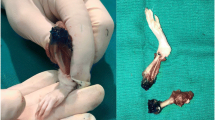Abstract
Objective
Intra-articular local anesthetics are often used for prevention of pain after arthroscopic knee surgery. However, the effect of local anesthetics other than bupivacaine on articular cartilage and synovium has not been studied. Also, complications associated with the injection of intra-articular bupivacaine have appeared in the literature. The aim of this study was to evaluate the effects of levobupivacaine on the articular cartilage and the synovium in rats.
Methods
Under aseptic conditions 0.25 ml (5 mg/ml) of levobupivacaine was injected into the right knee joint while 0.25 ml of saline was simultaneously injected into the left knee joint of 20 adult Sprague-Dawley rats. The purpose of saline injections was to serve as a control group. Groups of five rats were killed on days 1, 7, 14 and 21 after administration of injections. The knee joint samples were evaluated for the presence of inflammation in the articular and periarticular tissues and the synovium.
Results
There were no significant differences between the levobupivacaine and control groups with respect to inflammation in the articular and periarticular tissues and the synovium.
Conclusions
Although more studies are needed before final recommendations can be made, by evaluating the results obtained from this study, the clinical use of intra-articular levobupivacaine can be recommended for arthroscopic knee surgery.
Zusammenfassung
Ziel der Studie
Nach arthroskopischen Eingriffen am Knie werden zur Schmerzprophylaxe häufig intraartikulär Lokalanästhetika appliziert. Doch bisher wurde − mit Ausnahme von Bupivacain − kein Lokalanästhetikum hinsichtlich seiner Wirkungen auf Gelenkknorpel und Synovia untersucht. Zudem sind mit der intraartikulären Bupivacaininjektion vergesellschaftete Komplikationen beschrieben. Ziel der Studie war die tierexperimentelle Evaluierung der Effekte von Levobupivacain auf Gelenkknorpel und Synovia.
Methoden
Unter aseptischen Bedingungen wurden gleichzeitig 0,25 ml (5 mg/ml) Levobupivacain in das rechte Kniegelenk und 0,25 ml Natriumchloridlösung (Kontrolle) in das linke Kniegelenk injiziert. Verwendet wurden 20 ausgewachsene Sprague-Dawley-Ratten. Jeweils 5 Ratten wurden an den Tagen 1, 7, 14 und 21 nach den Injektionen getötet. Die Kniegelenkbiopsien wurden histologisch auf Entzündungszeichen in der Synovia sowie im intra- und periartikulären Gewebe untersucht.
Ergebnisse
Hinsichtlich der Entzündung im artikulären und periartikulären Gewebe sowie in der Synovia bestanden keine signifikanten Unterschiede zwischen der Levobupivacain- und der Kontrollgruppe.
Fazit
Für definitive Empfehlungen sind zwar noch weitere Studien erforderlich, doch aufgrund der hier vorgestellten Ergebnisse lässt sich schon jetzt zu einer intraartikulären Gabe von Levobupivacain nach arthroskopischen Eingriffen am Knie raten.

Similar content being viewed by others
References
Zeidan A, Kassem R, Nahleh N et al (2008) Intraarticular tramadol-bupivacaine combination prolongs the duration of postoperative analgesia after outpatient arthroscopic knee surgery. Anesth Analg 107:292–299
Elsharnouby NM, Eid HE, Abou Elezz NF, Moharram AN (2008) Intraarticular injection of magnesium sulphate and/or bupivacaine for postoperative analgesia after arthroscopic knee surgery. Anesth Analg 106:1548–1552
Dogan N, Erdem AF, Erman Z, Kizilkaya M (2004) The effects of bupivacaine and neostigmine on articular cartilage and synovium in the rabbit knee joint. J Int Med Res 32:513–519
Nole R, Munson NM, Fulkerson JP (1985) Bupivacaine and saline effects on articular cartilage. Arthroscopy 1:123–127
Sullivan SG, Abbott PJ Jr (1994) Cardiovascular toxicity associated with intraarticular bupivacaine. Anesth Analg 79:591–593
Liguori GA, Chimento GF, Borow L, Figgie M (2002) Possible bupivacaine toxicity after intraarticular injection for postarthroscopic analgesia of the knee: implications of the surgical procedure. Anesth Analg 94:1010–1013
Anakwenze OA, Hosalkar H, Huffman GR (2010) Case reports: two cases of glenohumeral chondrolysis after intraarticular pain pumps. Clin Orthop Relat Res 9:468
Chu CR, Izzo NJ, Papas NE, Fu FH (2006) In vitro exposure to 0.5% bupivacaine is cytotoxic to bovine articular chondrocytes. Arthroscopy 22:693–699
Gomoll AH, Kang RW, Williams JM et al (2006) Chondrolysis after continous intra-articular bupivacaine infusion: an experimental model investigating chondrotoxicity in the rabbit shoulder. Arthroscopy 22:813–819
Karaman Y, Kayali C, Ozturk H et al (2009) A comparison of analgesic effect of intra-articular levobupivacaine with bupivacaine following knee arthroscopy. Saudi Med J 30:629–632
Irwin MG, Cheung KM, Nicholls JM, Thompson N (1998) Intraarticular injection of ketorolac in the rat knee joint: effect on articular cartilage and synovium. Br J Anaesth 80:837–839
Moiniche S, Mikkelsen S, Wetterslev J, Dahl JB (1999) A systematic review of intra-articular local anesthesia for postoperative pain relief after arthroscopic knee surgery. Reg Anesth Pain Med 24:430–437
Jacobson E, Assareh H, Cannerfelt R et al (2006) The postoperative analgesic effects of intra-articular levobupivacaine in elective day-case arthroscopy of the knee: a prospective, randomized, double-blind clinical study. Knee Surg Sports Traumatol Arthrosc 14:120–124
Gristwood RW (2002) Cardiac and CNS toxicity of levobupivacaine: strengths of evidence for advantage over bupivacaine. Drug Saf 25:153–163
Saricaoglu F, Dal D, Atilla P et al (2008) Effect of intraarticular injection of lornoxicam on the articular cartilage and synovium in rat. Indian J Med Res 127:362–365
Acknowledgement
The corresponding author states that there are no conflicts of interest.
Author information
Authors and Affiliations
Corresponding author
Rights and permissions
About this article
Cite this article
Erden, I., Altinel, S., Saricaoglu, F. et al. Effect of intra-articular injection of levobupivacaine on articular cartilage and synovium in rats. Anaesthesist 61, 420–423 (2012). https://doi.org/10.1007/s00101-012-2007-3
Received:
Revised:
Accepted:
Published:
Issue Date:
DOI: https://doi.org/10.1007/s00101-012-2007-3
Keywords
- Injections, intra-articular
- Levobupivacaine
- Anesthetics, adverse effects
- Rats, Sprague-Dawley
- Knee joint surgery




